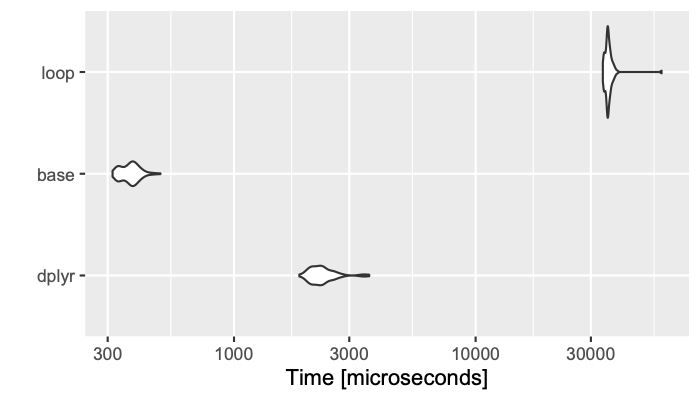Create a new variable that is the difference of two adjacent rows of ‘price’ variable in the data set, where the new variable is the squared difference.
test <- data.frame(id = c(6, 16, 26, 36, 46, 56),
house = c(1, 5, 10, 23, 25, 27),
price = c(79, 84, 36, 34, 21, 12))
where the new variable is diff = (79-84)^2 , (36-34)^2, (21-12)^2
The desired output would look like:
diff.data <- data.frame(price_diff = c(25, 4, 81))
I am trying to use the brackets to isolate the first and second rows, and take the difference and square, and repeat this over, for rows three and four, etc. but appreciate tips on how to approach this.
5 Answers
A few approaches that come to mind.
dplyr
For quick work, a dplyr approach, which has the handy lag() and lead() functions. First makes calculations for each row, then subsets to every other row, then pulls the calculated column.
library(dplyr)
test %>%
mutate(diff = (price - lead(price))^2) %>%
slice(seq(1, nrow(.), 2)) %>%
pull(diff)
[1] 25 4 81
base R
A base R approach, with fun recycled logical subsetting. This one is very clearly a vectorized operation, so naturally is the fastest.
(test$price[c(TRUE, FALSE)] - test$price[c(FALSE, TRUE)])^2
[1] 25 4 81
for loop
An inefficient-but-it-works approach:
inds <- seq(1, nrow(test), 2)
diff <- numeric(length(inds))
for (i in seq_along(inds)) {
diff[i] <- (test$price[inds[i]] - test$price[inds[i] + 1])^2
}
diff
[1] 25 4 81
Benchmarks
library(microbenchmark)
test_big <- data.frame(price = rnorm(100000, mean(test$price)))
res <- microbenchmark(
dplyr = {
diff1 <- test_big %>%
mutate(diff = (price - lead(price))^2) %>%
slice(seq(1, nrow(.), 2)) %>%
pull(diff)
},
base = {
diff2 <- (test_big$price[c(TRUE, FALSE)] - test_big$price[c(FALSE, TRUE)])^2
},
loop = {
inds <- seq(1, nrow(test_big), 2)
diff3 <- numeric(length(inds))
for (i in seq_along(inds)) {
diff3[i] <- (test_big$price[inds[i]] - test_big$price[inds[i] + 1])^2
}
}
)
all(c(identical(diff1, diff2), identical(diff2, diff3)))
print(res)
[1] TRUE
Unit: microseconds
expr min lq mean median uq max neval
dplyr 1864.352 2118.08 2338.2370 2274.1060 2443.4360 3628.295 100
base 314.306 346.04 372.9717 374.7605 391.6115 495.895 100
loop 33623.116 34868.37 35641.7231 35273.2225 35975.5525 58852.630 100
ggplot2::autoplot(res)
0
Here’s one solution with a for loop. Not efficient but it might be good enough.
test <- data.frame(id = c(6, 16, 26, 36, 46, 56),
house = c(1, 5, 10, 23, 25, 27),
price = c(79, 84, 36, 34, 21, 12))
index = seq(1,nrow(test)-1,by=2)
price_diff<-c()
for(i in index){
tmp<-test[c(i,i+1),]$price
price_diff[i] <- (tmp[2]-tmp[1])^2
}
return(price_diff)
Here is a data.table solution:
library(data.table)
DTt <- data.table(test)
DTt[, diff(price)^2, ][c(T,F)] # this line is added to microbenchmarking as "DT"
optimised base R 1 variant
(diff(test[, "price"])^2)[c(T,F)] # "base2"
and optimised base R 2 variant
(diff(test$price)^2)[c(T,F)] # "base3"
Using microbenchmarking from @knitz3 answer:
> print(res)
Unit: microseconds
expr min lq mean median uq max neval cld
dplyr 2921.2 3273.40 3889.982 3471.40 3877.70 17523.4 100 a
base 260.1 287.00 434.685 329.80 435.95 7442.6 100 b
loop 53704.1 55269.00 58833.461 56131.30 59930.90 206869.4 100 c
DT 226.3 247.15 315.890 315.70 372.15 431.6 100 b
base2 14.2 21.30 31.647 25.15 34.00 94.4 100 b
base3 7.5 11.40 20.489 16.90 31.40 48.1 100 b
1
-
Nice use of
diff()! Really takes the cake– knitz316 hours ago
df <- data.frame(id = c(6, 16, 26, 36, 46, 56),
house = c(1, 5, 10, 23, 25, 27),
price = c(79, 84, 36, 34, 21, 12))
library(tidyverse)
df %>%
mutate(diff_price = c(0, diff(price) ^ 2)) %>%
filter((row_number() - 1) %% 2 == 1)
#> id house price diff_price
#> 1 16 5 84 25
#> 2 36 23 34 4
#> 3 56 27 12 81
Created on 2023-11-07 with reprex v2.0.2
0
Try crossprod
> with(test, data.frame(price_diff = c(crossprod(c(1, -1), matrix(price, 2)))^2))
price_diff
1 25
2 4
3 81







